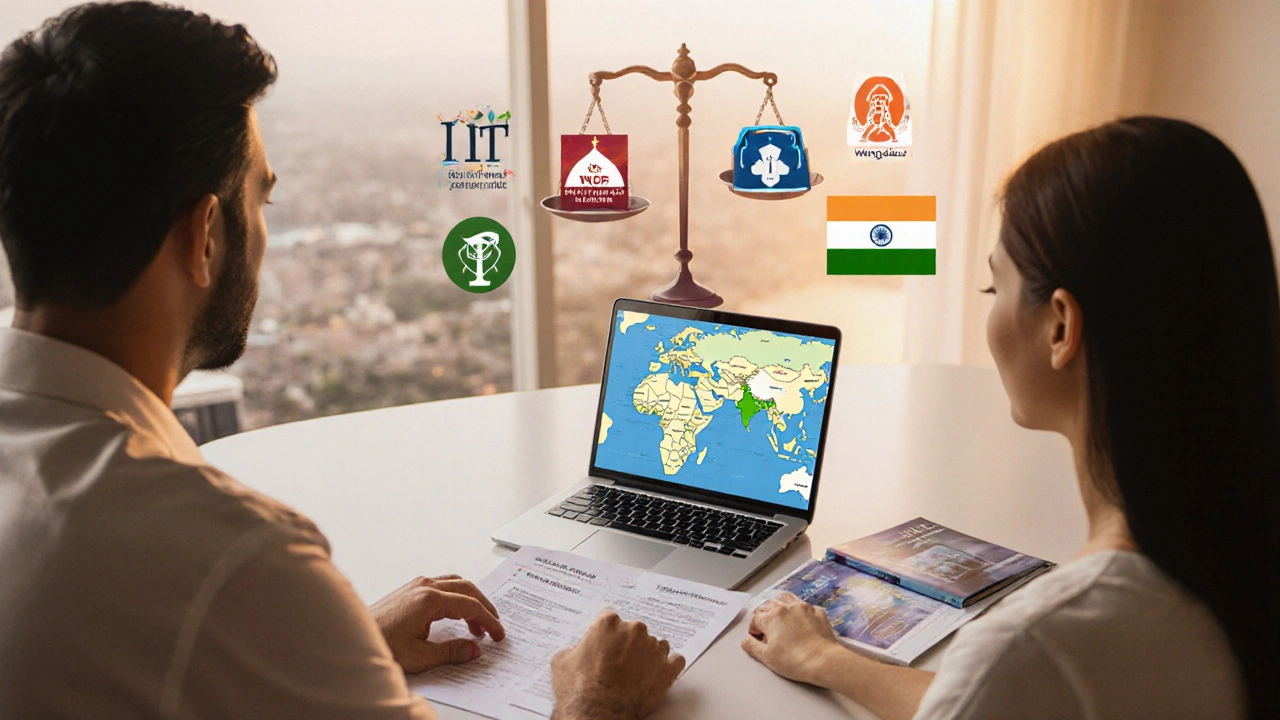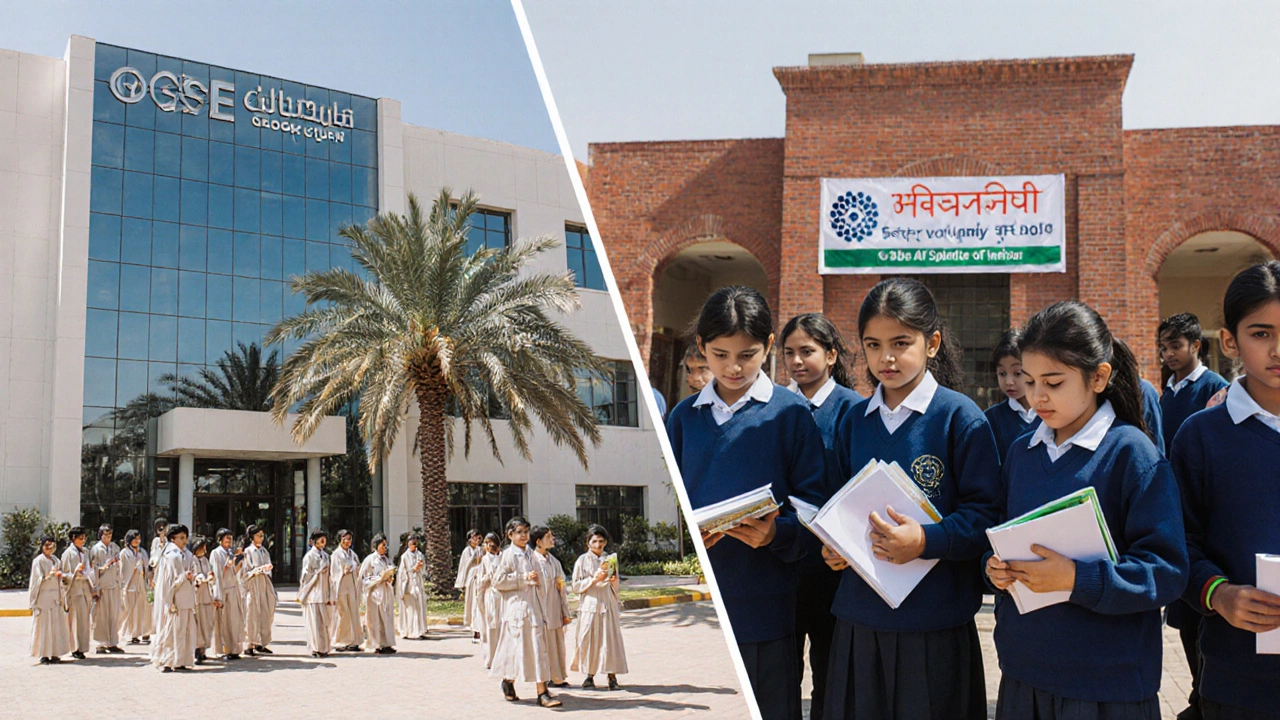CBSE Education Cost Comparison Calculator
Cost Comparison Tool
Calculate annual tuition costs for CBSE education in Dubai vs India based on your circumstances
Cost Comparison Results
Dubai CBSE Education
Base Tuition: AED (~USD )
Additional Costs: AED (~USD )
Total Annual Cost: AED (~USD )
India CBSE Education
Base Tuition: INR (~USD )
Additional Costs: INR (~USD )
Total Annual Cost: INR (~USD )
Recommendation
When parents in the Gulf or Indian diaspora wonder whether Dubai education vs India offers a better route for their kids, they’re really asking about curriculum rigor, exam pressure, cost, and future university doors. Let’s break down the two systems, focus on the CBSE syllabus that many Indian families follow, and see where each side shines or falls short.
What the Dubai Education System is a national framework overseen by the UAE Ministry of Education and the Knowledge and Human Development Authority (KHDA) looks like
Dubai’s schools can be broadly grouped into three tracks: the local Emirati track, the British and international tracks (IGCSE, IB), and the Indian track (CBSE, ICSE). The UAE Ministry of Education mandates a core of Arabic language, Islamic studies (for Muslims), and UAE social studies for all schools, regardless of the main curriculum. KHDA inspects schools annually and rates them on a six‑point scale (Outstanding, Very Good, Good, Acceptable, Weak, Very Weak). The most common public‑private hybrid schools score “Very Good” or “Outstanding,” reflecting strong facilities and teacher qualifications.
How the Indian Education System is coordinated by the Central Board of Secondary Education (CBSE) for most K‑12 schools is structured
CBSE runs a national curriculum for over 21,000 schools in India and abroad. Its syllabus emphasizes Science‑Math focus, continuous internal assessment (CIA), and a high‑stakes board exam at the end of Class 10 and Class 12. The board’s grading: A1 (91‑100), A2 (81‑90), B1 (71‑80), and so on, with a 33% pass mark at the secondary level. CBSE also aligns with national entrance exams like NEET (medical) and JEE (engineering), shaping teaching methods toward those test patterns.
Curriculum Depth and Breadth
Both systems offer a mix of local content and global perspectives, but the emphasis differs.
- Core subjects: Dubai’s Indian schools follow the CBSE textbook list, identical to Indian schools, while UAE‑based schools add mandatory Arabic and UAE social studies.
- Electives: In Dubai, students can pick from IB, IGCSE, or vocational tracks from age 14 onward, giving a broader range of science‑humanities combos. CBSE offers limited electives (e.g., Computer Science, Physical Education) and often requires a second language like Hindi, Sanskrit, or a foreign language.
- Language of instruction: Dubai’s international schools teach in English, but the Arabic & Islamic components are taught in Arabic. In CBSE schools, English is the medium for most subjects, with Hindi/Regional language as a second language.
Assessment Styles and Exam Pressure
Assessment can make or break a student’s experience.
| Aspect | Dubai (CBSE track) | India (CBSE) |
|---|---|---|
| Board Exams | Class 10 & 12 CBSE papers (same as India) | Class 10 & 12 CBSE papers |
| Continuous Assessment | 30% internal, 70% board (KHDA may add projects) | 20-30% internal, rest board |
| Additional Exams | IGCSE/IB optional, often less stressful | None; focus on NEET/JEE prep |
Dubai schools often sprinkle project‑based grading (KHDA requires a portfolio) that can reduce pure exam pressure. In India, the board exams dominate the final grade, and the competition for limited seats in elite colleges amplifies stress.
Teacher Qualification and Training
Quality teachers are the backbone of any system.
- Dubai: KHDA requires teachers to hold a minimum of a bachelor’s degree in education or the subject they teach, plus a teaching license from the Emirates. Many schools recruit expatriate teachers with Master’s degrees and international certifications (e.g., PGCE, TESOL).
- India: CBSE mandates a B.Ed. or a relevant post‑graduate qualification. However, rural schools sometimes face shortages, leading to higher student‑teacher ratios (average 1:35) versus Dubai’s typical 1:20 in private institutions.
Result: Dubai classrooms often have more exposure to varied teaching styles and continued professional development, while Indian CBSE schools may rely heavily on rote learning, especially in high‑stakes exam years.
Cost, Accessibility, and Class Sizes
Money matters for most families.
- Tuition fees: Dubai’s private CBSE schools charge anywhere from AED 15,000 (~USD 4,000) to AED 45,000 (~USD 12,000) per year, depending on facilities. Indian CBSE schools range from free (government) to INR 80,000 (~USD 960) for elite private institutions.
- Class size: Dubai’s private sector caps classes at 25-30 students, a KHDA recommendation. Indian CBSE schools often exceed 40 students, especially in government schools.
- Scholarships: Dubai’s Dubai Knowledge and Human Development Authority (KHDA) runs merit‑based scholarships for high‑performing Emirati students. In India, many CBSE schools offer fee waivers for top‑rankers, but these are limited.

Higher‑Education Pathways
Where students end up matters for parents deciding between Dubai and India.
- Dubai CBSE graduates can apply to UAE universities (e.g., University of Dubai, Khalifa University) that accept CBSE marks, but many still aim for Indian institutions like IITs or AIIMS, using the same board scores.
- Indian CBSE graduates have a direct pipeline to Indian engineering and medical colleges via JEE and NEET, respectively. Internationally, many top universities (US, UK, Canada) recognize CBSE scores, though they may request additional SAT/ACT or A‑Level results.
- Dubai students also have the option to switch to IB or A‑Levels in later years, which can boost chances for western universities.
Pros and Cons Checklist
| Factor | Dubai (CBSE track) | India (CBSE) |
|---|---|---|
| Curriculum breadth | Broad (Arabic, UAE studies, optional IB/IGCSE) | Narrow (focus on CBSE core) |
| Exam pressure | Board + project mix, slightly less stress | Board‑centric, high stakes for JEE/NEET |
| Teacher quality | Higher average qualifications, international exposure | Variable, often large class sizes |
| Cost per year | AED 15‑45 k (USD 4‑12 k) | Free‑₹80 k (USD 0‑1 k) |
| University access | UAE & Indian universities; optional IB/IGCSE for West | Indian IIT/AIIMS; global recognition with extra tests |
| Class size | 20‑30 | 30‑45 (public), 20‑30 (private) |
How to Choose the Right System for Your Child
There’s no one‑size answer, but consider these decision points:
- Future location: If you plan to settle in the UAE or the Gulf, a Dubai‑based CBSE school gives smoother integration with local regulations and a chance to learn Arabic.
- Academic goals: For engineering or medical aspirants targeting Indian entrance exams, the Indian CBSE environment aligns closely with JEE/NEET preparation.
- Financial capacity: Evaluate tuition against expected return. Government CBSE schools in India are cost‑effective, while Dubai private fees pay for smaller classes and better facilities.
- Learning style: If your child thrives on project‑based work and multilingual exposure, Dubai’s hybrid model may be more engaging.
- Family support: Consider the cultural adjustment-Arabic language classes and UAE cultural norms might require extra support for Indian families.
Ultimately, the “better” system is the one that matches your child’s strengths, family plans, and budget. Both Dubai and India offer solid CBSE pathways; the difference lies in environment, cost, and ancillary subjects.
Is the CBSE syllabus the same in Dubai as in India?
Yes. Dubai’s Indian schools that follow CBSE use the same textbooks, grading scheme, and board exam schedule as schools in India. The only addition is the mandatory Arabic, Islamic studies, and UAE social studies required by the UAE Ministry of Education.
Do Dubai CBSE schools prepare students for JEE and NEET?
Most Dubai CBSE schools run dedicated JEE/NEET coaching after school hours or integrate problem‑solving drills into the regular science curriculum, so students are well‑prepared for those exams.
How does class size affect learning outcomes?
Smaller classes (20‑30) allow more individual attention, quicker feedback, and better classroom management. Larger classes (35‑45) can limit interaction and increase reliance on textbook learning, which may impact exam performance.
Are scholarships available for Indian expatriates in Dubai?
Scholarships are mostly offered by individual schools based on merit, as well as KHDA’s merit‑based programs for Emirati nationals. Indian expatriates can apply for school‑specific awards, but they are limited compared to UAE citizen scholarships.
Which system offers better university placement abroad?
Dubai students benefit from optional IB or A‑Level tracks, which many western universities view favorably. Indian CBSE graduates can also secure spots abroad, but they usually need additional qualifications like SAT, ACT, or the International Baccalaureate diploma.



